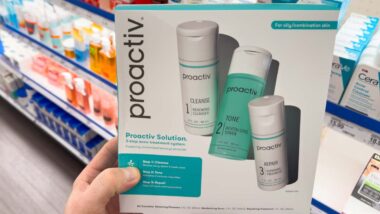Top Class Actions’s website and social media posts use affiliate links. If you make a purchase using such links, we may receive a commission, but it will not result in any additional charges to you. Please review our Affiliate Link Disclosure for more information.

What is Stevens Johnson Syndrome?
Stevens Johnson syndrome (SJS) is a rare, life-threatening condition that affects the skin and mucous membranes in the mouth, nose, eyes and other parts of the body. According to the Mayo Clinic, SJS usually requires hospitalization so that doctors can eliminate the cause, control symptoms, and help skin regrow quickly and without complications.
Early symptoms of Stevens Johnson syndrome may resemble flu-symptoms, including fever, sore throat/mouth, fatigue, coughing, and burning eyes. After these symptoms, patients will develop more serious symptoms affecting their skin and mucous membranes. Symptoms may include unexplained skin pain, red/purple skin rashes that spread across the body, and blisters on the skin and mucous membranes.
After the blisters form, the top layer of the skin dies and sheds. After this, it can heal and regrow but the skin death and shedding process can lead to secondary skin infections. Further infections in patients with SJS can lead to life-threatening sepsis (blood infection).
Other SJS complications include eye problems ranging from minor eye irritation and dryness all the way to blindness. Some patients may also develop lung problems that lead to acute respiratory failure.
What Are the Causes of Stevens Johnson Syndrome?
In about half of its occurrences, as indicated by Merckmanuals.com, SJS is caused by an adverse reaction to a medication. It can also be caused as a side effect of a bacterial infection or vaccination. When it comes to an outbreak in the pediatric population, the precursor is almost always an infection. Sometimes, it is difficult across the age spectrum to identify the cause of the condition.
Medications that may cause SJS include:
- Seizure medications (anticonvulsant) such as Lamictal
- Mental illness medications (antipsychotics)
- Anti-gout medications such as allopurinol
- Pain relievers such as acetaminophen, ibuprofen, and naproxen sodium
- Antibiotics such as penicillin
SJS may also be caused by infections such as pneumonia, herpes simplex, herpes zoster, HIV, and Hepatitis A.
What is Toxic Epidermal Necrosis?
According to Merckmanuals.com, the diagnosis of Toxic Epidermal Necrosis (TEN) over SJS is merely a matter of the degree to which the skin is affected. SJS generally affects small patches of skin and mucous membranes amounting to roughly ten percent of the body. The next level of the diseased state is a blurred line between SJS and TEN when the skin affected equals 15 to 30 percent of the body’s epidermal tissue. Finally, TEN is more definitively diagnosed when 30 percent of the body’s skin is diseased. Of course, the greater the involvement, the more danger to the patient. The Merckmanuals.com website clearly indicates that just about every case of TEN is the result of a reaction to medication.
How Are SJS and TEN Treated?
According to WebMD, the first priority in SJS and TEN treatment is identifying and eliminating the cause of the condition. This may mean stopping certain medications or treating an underlying infection. After the cause of SJS is managed, doctors will focus on replenishing fluids, taking care of healing skin, and making sure that the eyes are taken care of. Treatment may take weeks or months.
Since the affected skin must be shed and underlying tissue strengthened, the inpatient level of treatment usually occurs within the confines of a hospital burn unit. During treatment, physicians may immune globulin, do a blood plasma exchange, or offer cyclosporine to reduce the time span of active skin blistering.
How Long Does It Take to Recover from Stevens Johnson Syndrome or Toxic Epidermal Necrosis?
While being treated, patients may be in the hospital for two to four weeks. In severe cases, treatment may take months – especially if complications such as sepsis, fluid in the lungs, and organ failure arise. The death rate is five percent of patients across the age spectrum, as indicated by Merckmanuals.com. In terms of TEN, 25 percent of adults who contract the syndrome may succumb and this figure increases in older populations. The childhood mortality rate is under ten percent. Patients will recover from Stevens Johnson syndrome and TEN quickly if they are young and healthy, but the entire year after developing either condition is filled with risk regardless of overall health.
Even if patients undergo treatment and the relevant condition is cured, they may still deal with symptoms for years due to the damage Stevens Johnson syndrome or TENS can cause. Long term symptoms may include:
- Skin scars from the peeling rash;
- Dry eyes that are sensitive to bright lights;
- Vision problems;
- Gum and mount infections;
- And lung problems.
Symptoms may vary depending on how early the condition was caught and how long severe symptoms lasted before they were resolved.
If you or a loved one developed a Lamictal rash or other serious Lamictal side effects, you may qualify to pursue compensation by filing a Lamictal lawsuit. See if you qualify by filling out the short form on this page. It’s absolutely free to participate, so act now!
ATTORNEY ADVERTISING
Top Class Actions is a Proud Member of the American Bar Association
LEGAL INFORMATION IS NOT LEGAL ADVICE
Top Class Actions Legal Statement
©2008 – 2024 Top Class Actions® LLC
Various Trademarks held by their respective owners
This website is not intended for viewing or usage by European Union citizens.
Get Help – It’s Free
Join a Free Lamictal Lawsuit Investigation
If you believe your diagnosis was caused by Lamictal, you may be entitled to compensation by filing a Lamictal lawsuit. Learn more by filling out the form on this page for a free case evaluation.
An attorney will contact you if you qualify to discuss the details of your potential case.
PLEASE NOTE: If you want to participate in this investigation, it is imperative that you reply to the law firm if they call or email you. Failing to do so may result in you not getting signed up as a client or getting you dropped as a client.
Oops! We could not locate your form.












